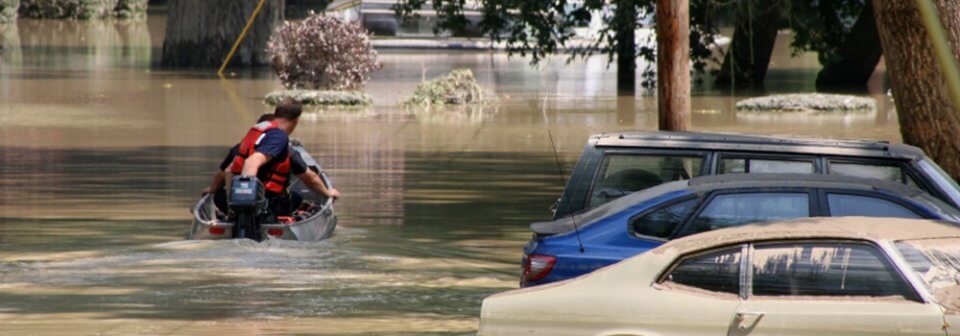
Flood-damaged cars are most likely to turn up in states affected by coastal and river flooding, and it’s important to consider matters related to auto insurance when buying a used car. Here’s a list from most to least flood-damaged, from CarFax: Texas, New Jersey, Pennsylvania, Kentucky, Louisiana, Illinois, New York, Florida, Missouri and Virginia. All used car buyers are advised to have a car inspected by a reputable mechanic before buying it.
Facts: Flood Damage from Hurricanes and Tropical Storms
Hurricane Floyd (1999) damaged 75,000 vehicles and more than half were put back out on the road.
Tropical Storm Allison (2001) damaged more than 95,000 vehicles by the most extensive tropical storm in U.S. history.
Hurricane Ivan (2004) – Left more than 100,000 cars submerged in floodwaters throughout the Southeast.
Hurricane Katrina, Hurricane Rita and Hurricane Wilma (2005) – claimed more than 600,000 cars across the Gulf Coast. Many of these cars still are showing up for sale around the country.
Hurricane Ike (2008) – more than 100,000 cars in Texas and Louisiana, from Galveston and Houston over to Baton Rouge, were left underwater.
Take Off the Rose-Colored Glasses – Be a Smart Shopper
Talk to a reputable dealer. Established dealerships know that protecting their good public image is worth its weight in gold to them. What to do:
- Ask if the car has flood damage (and get the answer in writing). If you can’t get this assurance, it’s time to walk away.
- Ask to see the title (look for a stamp that reads “Flood” or “Salvage,” required by law in some states. At the very least, check to see if the car came from a flood damaged area
- Be wary of vehicles priced way under market value. If it’s too good to be true, it usually is
A “salvage title” means the car was declared a total loss by an insurance company because of a serious accident or some other problems. A “flood title” means the car has damage from sitting in water deep enough to fill the engine compartment. The title status is part of a vehicle history report.
Signs you may be looking at a flood-damaged vehicle:
- Musty or moldy odors
- Musty or moldy odors inside the car are a sign of mildew buildup from prolonged exposure to water. Note: A strong air freshener or cleaning solution scent may mask the mildew odor
- Check the air-conditioner to see if a moldy smell comes from the vents
- Carpeting
- Look for discolored carpeting
- Check for moisture by feeling the carpet
- If possible, peel back the carpet to see if you can feel moisture between the carpet and the car body
- You may also see other signs of water damage, such as rust, by looking under the carpet
- Open the trunk and check the carpet.
- Remove the spare tire and feel the material underneath
- Compare the floor carpet to the upholstery on the doors and the roof to be sure they all appear to be the same age and color.
- Faulty Fabrics
- Look for blotchy, brown water stains on all the upholstery — front, back and under the seats
- If the car is 10 years old but the upholstery looks new, be suspicious
- Check to see the upholstery matches – look for sections that are a different color, faded, newer or with patterns that don’t line up
- Large stains or differences in color between lower and upper upholstery sections may indicate that standing water was in the vehicle
- Recognize Rust
- Check the exterior paint for bubbles near rubber or chrome (a sign that there’s rust under the paint).
- Check for rust on screws, door hinges, hood springs, trunk latches or brackets under the dashboard
- Use a mirror to check below the seats for rusty springs
- Check the Oil
- A reading of an oil level that’s too high may indicate water in the engine
- Inspect the exterior for water buildup
- Check for fogging inside headlamps or taillights
- A water line might be visible in the engine compartment or the trunk
- Inspect the interior for water buildup
- Check for fogging inside the instrument panel and interior and exterior mirrors.
- Bend the wires underneath the dashboard. (After drying, wet wires become very brittle)
- Dirt buildup in unusual areas
- These include areas such as around the seat tracks or the upper carpeting under the glove compartment
- Have a certified mechanic inspect the vehicle for caked mud or grit in alternator crevices, behind wiring harnesses and around the small recesses of starter motors, power steering pumps and relays
The National Insurance Crime Bureau (NICB) maintains a free database that includes flood damage and other information so you can investigate a car’s history by its vehicle identification number (VIN).
If you suspect a local car dealer is committing fraud by knowingly selling a flood car or a salvaged vehicle as a good-condition used car, contact your auto insurance company, local law enforcement agency or the NICB at (800) 835-6422.
Don’t get caught without flood insurance when the next big storm hits. Contact Freeway Insurance today at (800)777-5620 to find to find out if flood insurance is available in your area.



